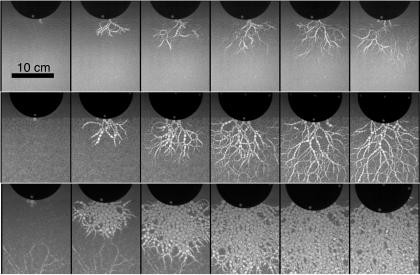What Really Happens Underground During a Missile or Meteor Strike?
| Ana Verayo | | Apr 12, 2015 07:01 AM EDT |
(Photo : Abram Clark/Duke University) Frames from a high-speed video of a metal object slamming into a bed of artificial soil, sand or rock.The changing impact forces illuminated in each frame help explain why soil and sand get stronger when they're struck harder.
Scientists have wanted to understand how a missile or a meteor might affect the ground underneath our feet apart from the obvious devastation these events cause above ground.
A new study conducted by Duke University physicists involved developing new techniques using simulations of high speed impacts on artificial soil and sand inside the laboratory. Scientists then recorded these experiments in close-up and super slow motion.
Like Us on Facebook
Researchers reveal that materials similar to soil and sand apparently become stronger when struck harder. The findings also show why ground penetrating missiles have only limited success when they are fired at high speeds. Projectiles are apparently prone to more resistance and stop sooner, especially when fired at increasing speeds.
The study was funded by the Defense Threat Reduction Agency and aimed to achieve better control in the design of earth penetrating missiles meant to annihilate deeply buried underground targets similar to enemy bunkers or underground stockpiles of weapons.
To produce a simulation of a missile or meteor impact, researchers dropped a metal projectile with a round tip from a ceiling height of seven feet at a pit of beads. When it came to the moment of collision, the projectile's kinetic energy was immediately transferred into the beads and dissipated when the beads bumped into each other below the surface, causing the beads to absorb the force of the collision.
To observe these forces at the point of impact, researchers used clear plastic beads that transmitted light when compressed. Areas that revealed the greatest force from the impact showed chains of light branching out, an effect called "force chains" that are transferred from one bead to the next, similar to lightning.
During low speeds, the network of beads carries more force but when compared to high-speed projectiles, the force chains grow more extensive and the impact energy is dispersed away from the target faster, said co-author of the study Robert Behringer.
This study was published in the journal, Physical Review Letters.
TagsWhat Really Happens Underground During a Missile or Meteor Strike?, missile strike, meteor strike, underground ground missile meteor hits earth
©2015 Chinatopix All rights reserved. Do not reproduce without permission
EDITOR'S PICKS
-

Did the Trump administration just announce plans for a trade war with ‘hostile’ China and Russia?
-

US Senate passes Taiwan travel bill slammed by China
-

As Yan Sihong’s family grieves, here are other Chinese students who went missing abroad. Some have never been found
-

Beijing blasts Western critics who ‘smear China’ with the term sharp power
-

China Envoy Seeks to Defuse Tensions With U.S. as a Trade War Brews
-

Singapore's Deputy PM Provides Bitcoin Vote of Confidence Amid China's Blanket Bans
-

China warns investors over risks in overseas virtual currency trading
-

Chinese government most trustworthy: survey
-

Kashima Antlers On Course For Back-To-Back Titles
MOST POPULAR
LATEST NEWS
Zhou Yongkang: China's Former Security Chief Sentenced to Life in Prison

China's former Chief of the Ministry of Public Security, Zhou Yongkang, has been given a life sentence after he was found guilty of abusing his office, bribery and deliberately ... Full Article
TRENDING STORY

China Pork Prices Expected to Stabilize As The Supplies Recover

Elephone P9000 Smartphone is now on Sale on Amazon India

There's a Big Chance Cliffhangers Won't Still Be Resolved When Grey's Anatomy Season 13 Returns

Supreme Court Ruled on Samsung vs Apple Dispute for Patent Infringement

Microsoft Surface Pro 5 Rumors and Release Date: What is the Latest?










